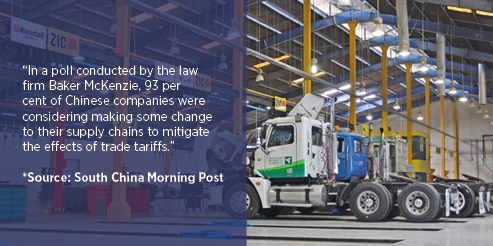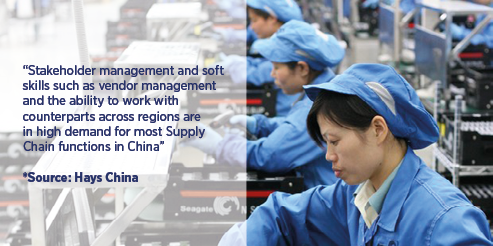The Inside Story of Supply Chain in China

China, the second largest economy and leading provider of manufacturing services in the world, has recently seen troubling developments in its ever-growing export markets. Since 2018, the ongoing ‘trade war’ initiated by the U.S. has destabilised industries the world over and disrupted China’s position as the heart of global supply chain systems. Rising tariffs, political tensions and the resulting economic slowdown have put reactiveness, change management and strategic planning at the forefront of supply chain management (SCM) functions in the country, alongside an ongoing focus on digital transformation.
Labour market overview: China stays afloat amidst turbulent waters
Despite the continuing onslaught of tariffs that show no sign of slowing, China’s domestic strength and global influence has kept its economy surprisingly stable. According to economic research consultancy Capital Economics, the reasons for this include a strategically weaker yuan, strong domestic markets and the country’s decision to ship U.S.-bound exports to other Asian countries to circumvent the tariffs. While U.S. demand was affected, these remedial factors resulted in China eventually seeing a slight increase in its exports, bringing it up to almost 12 per cent of the world’s total [1].This combination of volatility and stability is reflected in China’s Supply Chain labour market as well.
North-East China
The city centre of Shanghai, for example, has seen some movement in terms of U.S.-based companies moving their sourcing offices to neighbouring countries like Bangladesh and Vietnam. But MNC companies have remained relatively stable as compared to last year, explains Caroline Lin, the Section Manager for Procurement & Supply Chain at Hays China. “The slowing economy has led these companies to focus more on driving digital transformation, like omni-channel and e-commerce supply chains. Their objective is to build up their digital supply chain systems.” Next door in Suzhou, there has been a significant impact on the B2B sector and sourcing function. “Companies are trying to keep costs as low as possible because they are unsure how their future revenues will be impacted by rising tariffs,” says Christian Lepolard, Business Director for Hays Suzhou. “The trade war has forced them to review and further optimise their supply chain and sourcing strategy. If they have to export to the U.S., for example, but keep manufacturing in China, then the only way to absorb the raise in tariffs is to decrease costs, starting with the price for raw materials. Industries in consumer sector like FMCG and e-commerce, are also moving in this direction.”
South China
In the industrial centre of Guangzhou, Cece Tang, Team Manager for Procurement at Hays Guangzhou, observed a shift in labour market activity from B2B to B2C. “Last year, the majority of our placements came from the industrial sector. But this year, the focus is on companies who are selling within China, so the supply chain industry is now focussing on retail and FMCG.” Similarly in Shenzhen, the impact of the trade war on U.S. companies has been significant, with a number of them moving out to Cambodia or Vietnam due to the rising cost of raw materials and manufacturing. “Some U.S. companies are making a business transformation from manufacturing to sourcing because China still has the technological and engineering capabilities for manufacturing. So they will still keep the supply chain in here but move the manufacturing out,” says Lillian Chen, Team Manager for Manufacturing and Ops at Hays Shenzhen. General economic growth remains stable, however, owing to government policies that support SMEs in the region and continued investment from European companies, especially in raw materials.

Skills in Demand: Business Transformation at the Forefront
According to a poll conducted by law firm Baker McKenzie, 93 per cent of Chinese companies were considering making some change to their supply chains in the wake of trade tariffs. Of these, 18 per cent were considering a complete supply chain and production transformation, 58 per cent were making major changes, 17 per cent were making small changes, and only seven per cent were making no changes at all [2]. This focus on change has greatly informed the demand for specific supply chain skills in the country.
Business transformation capabilities, for example, are at the top of the list. According to Catherine Zhang, Team Manager for Procurement & Supply Chain at Hays Shanghai, “For senior roles, this translates into end-to-end supply chain experience, merger and acquisitions knowledge, understanding of SOP (standard operating procedures) and implementing compliance and IBP (integrated business planning).” The corresponding senior roles in demand are Supply Chain Director, Supply Chain Excellence and specific IBP roles. Similarly, demand planning skill sets are also gaining more importance, owing to the part they play in setting up a company’s overall M&P (maintenance and procurement) process, as well as improving supply chain processes to make them more efficient and connected than before. Demand planning roles have been hot in the market for recent years, but skilled talent for these roles are still in huge demand. While the supply chain labour market currently favours employers, this is one niche area where suitable candidates can still have bargaining leverage. There has also been a rise in demand for indirect procurement skills and strategy, owing to its critical impact on costs.
Soft Skills Highly Desired
Since companies are trying to keep their costs low during this time of transformation, the ideal candidate would be good at identifying suppliers, negotiating terms and conditions, and have an existing network of useful connections. Stakeholder management and soft skills, which are directly related to succeeding in this function, will also help set a candidate apart. In fact, stakeholder management and soft skills such as the ability to work with counterparts across regions, are in high demand in most Supply Chain functions spanning both leadership and mid-level roles.

Mid-level roles such as Sourcing Managers, Planning Managers and Commodity Managers are also very much in demand at the moment. Mid-level candidates are expected to have a good amount of technical and operational experience to work independently, but also coordinate across departments. Cross border trading experience and market insights are also highly desired traits. Finally, there is also an uptick in ‘reactiveness’ as a requirement from employers, with recent events showing that proactivity is no longer enough. The experience and ability to react and adapt quickly to change has become increasingly important in the last year.
Candidates encouraged to upskill – Employers encouraged to strengthen candidate attraction strategy
For China’s supply chain industry at large, the jobs market currently favours employers as a conservative outlook and widespread cost cutting has led to more candidates in the market than roles. This puts candidates at a disadvantage when it comes to pay raises, flexible working and other benefits, while stressing the importance of upskilling. However, for potential employers, this means that high-value candidates who are already gainfully employed are not likely to leave their current role unless offered a significant upgrade and roadmap for progression. The domestic focus has also led to less opportunity for foreign workers, meaning that companies have to offer outstanding packages and benefits if they are to attract the right local candidates in this market.
For those vying for senior level roles, upskilling in change management could significantly increase their market value. Change management is essentially a combination of solid industry knowledge, stakeholder management, strategic planning, leadership skills, and global market insights – organisations that are on the path to change are specifically looking for senior candidates who can leverage this know-how and advise the company on its best way forward. On the employer side, some companies (especially in the industrial regions) are ready to invest in professional upskilling for their senior and top performing employees. This includes supply chain certifications like CSCP, CPIM, and additional certifications for people in supply chain and procurement.
A digital future
Last year marked the rise of automation in supply chain in China, such as the increasing use of robots in warehouses to improve efficiency and security. This trend has continued into this year, with an increasing focus on digitalisation owing to more Chinese companies recognising and embracing the potential benefits of IoT and AI to digitising the supply chain. A recent report by Deloitte defined this shift from, “linear, sequential supply chain operations to an interconnected, open system of supply operations could lay the foundation for how companies compete in the future,” as a digital supply network (DSN) [3]. Digital skills like data analysis and IT knowledge are currently in demand and are likely to grow exponentially along with industry 4.0. Keen candidates can highlight their technical backgrounds and IT experience as the current trend in supply chain is to minimise error and increase efficiency. The whole function is moving towards an increasing importance on technical skills and the ability to monitor workflow, owing to the rise of automation.
Much like its economy, China’s supply chain labour market has proven resilient in the face of change. And while restructuring is both imminent and ongoing, opportunities remain for qualified candidates who can augment their negotiations by preparing and upskilling to best equip themselves to this change. Focusing on digital skills and communication could well be the differentiating factors for a supply chain hopeful, provided they also exhibit the resilience and resourcefulness precipitated by China’s current economic climate.
If you would like to discuss this report in more depth or you wish to discuss your recruitment needs, please email:
Shanghai: Caroline Lin at Caroline.Lin@hays.cn
Suzhou: Chandler He Chandler.He@hays.cn
Guangzhou: Cece Tang at Cece.Tang@hays.cn
Hays research
Hays Workforce Trends In 2024: Accountancy and Finance
China’s Technology Talent Trends for 2024
DNA series
